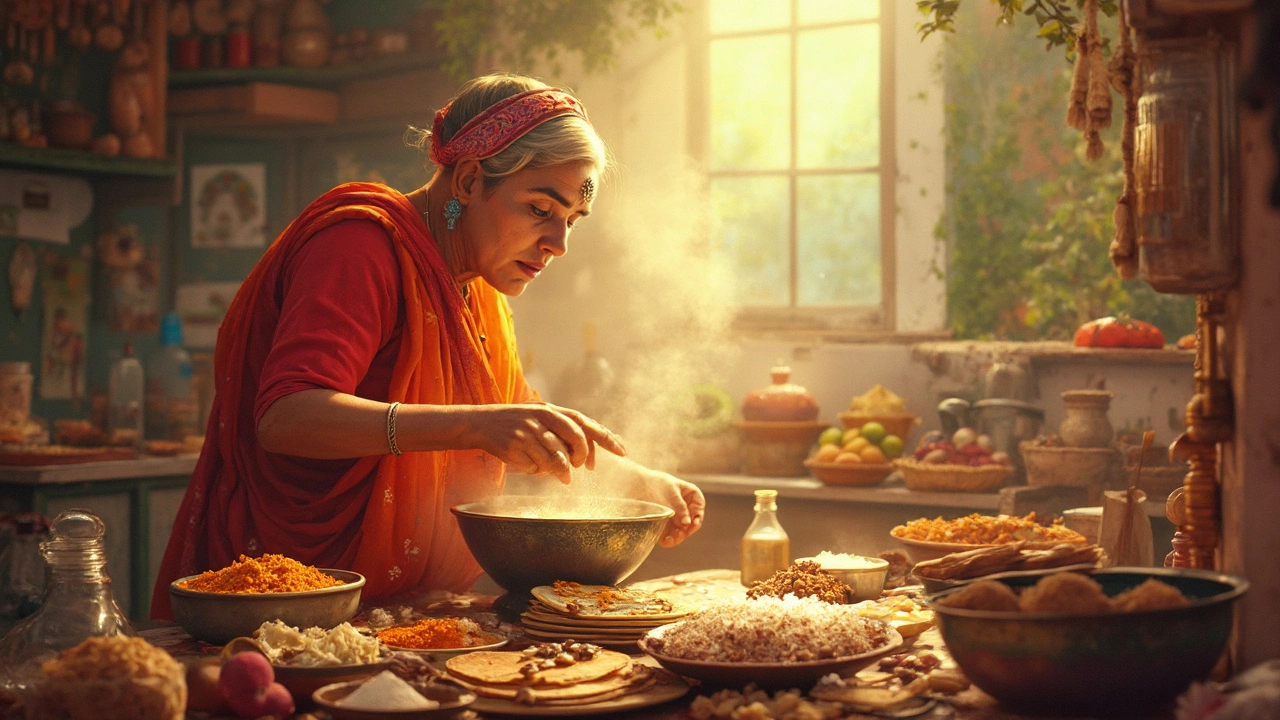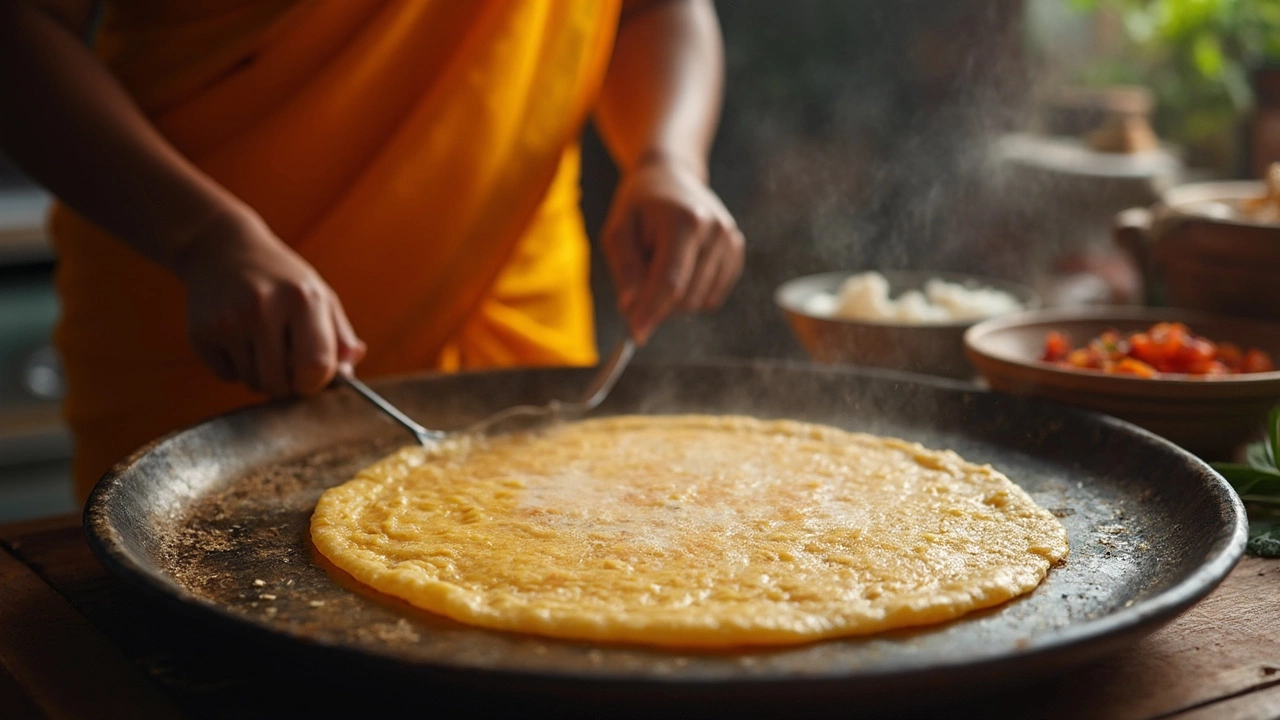The Quick Guide to Making Perfect Dosa Batter Without Yeast
 Feb, 14 2025
Feb, 14 2025
Mumbai mornings just aren't complete without a crispy dosa on the plate, right? Crafting the perfect dosa batter doesn't need to be a long, drawn-out affair. If you're pressed for time but still craving that golden perfection, this guide is here to save the day.
First off, let's talk ingredients. Skip the exotic trips to specialty stores — you want to grab parboiled rice and split urad dal (that's black gram lentils for the uninitiated). Toss a small spoonful of fenugreek seeds into the mix. Why? These tiny seeds aren't just for show; they help in fermentation and enhance the flavor without a hint of yeast.
Now, about the process. Soak your rice and dal separately, adding the fenugreek to the dal for best results. Four to five hours should do the trick, which is surprisingly short compared to some other Indian recipes. Remember — you're not preparing for a marathon, just a quick, delightful dosa breakfast future self will thank you for.
- Selecting the Right Ingredients
- The Perfect Soaking and Grinding Method
- Fermentation Tips and Tricks
- Storing and Using Dosa Batter Efficiently
Selecting the Right Ingredients
Choosing the right mix of ingredients can make or break your dosa batter. You'll want to start with two main players: parboiled rice and split urad dal. These form the backbone of your batter, giving it the right texture and flavor.
Rice: The Foundation
For quick dosa batter, parboiled rice is your go-to choice. It cooks evenly and helps achieve the desired crispiness. Aim for a ratio of about 3:1 when you're gauging rice to lentil proportions. So, if you have three cups of rice, pair them with one cup of urad dal.
Split Urad Dal: The Binder
Split urad dal is crucial. It acts as the binding agent, holding your yeast-free dosa together and lending that signature fluffy texture. Always choose high-quality dal, preferably skinless, to ensure the smoothest batter.
Fenugreek Seeds
Now, don't skip those fenugreek seeds. Adding a teaspoon enhances both flavor and consistency. Bonus: they naturally aid fermentation, making your dosas tastier without any yeast.
Optional Ingredients
If you're feeling adventurous, sprinkle in a touch of flattened rice or poha during soaking. It can add an extra dimension of softness, but remember — less is more.
Let's also talk quick fixes. A pinch of sugar or a handful of cooked rice can enhance the fermentation if you're in a rush and dealing with cooler surroundings.
| Ingredient | Purpose |
|---|---|
| Parboiled Rice | Gives crispiness |
| Split Urad Dal | Acts as binder |
| Fenugreek Seeds | Enhances fermentation |
In sum, nailing the ingredient selection means you're more than halfway to glorious homemade dosas. Keep these points in mind the next time you're making Indian cooking magic.
The Perfect Soaking and Grinding Method
Getting your dosa batter just right starts with the soaking and grinding method. This is the foundation of making those perfect, crispy delights. So, let's hit the ground running! This method is for those who want to enjoy their dosas sans yeast.
The Soaking Stage
First up, you've got to soak your rice and dal. Keep them separate to start with, and add a tiny bit of your secret weapon—fenugreek seeds—into the dal. This step isn’t negotiable. Soaking for about 4 to 5 hours will soften them up nicely. Too short, and you’ll end up with batter that just won’t play ball. Trust me; you’ll thank yourself later.
Moving on to Grinding
Next, grab a trusty grinder or a high-speed blender. You'll need to blend them in batches. Start with the urad dal mix along with its soaking water. Get it to a smooth paste with a slightly frothy texture. Need a visual cue? You’re aiming for a consistency like cake batter, not too thick or thin.
Time for the rice! Pulse it until it's sort of smooth. You’re looking for a texture with slight grittiness—that’s the magic trick for getting crispy edges on your dosa. Mix both pastes thoroughly in a large bowl.
Final Touches
Fermentation often seems like a time thief, but not here. The right balance of fenugreek and the warm climate in most kitchens will naturally ferment this mixture within 6 to 8 hours. But pro tip? If you want it faster, pop it in an oven with a light turned on. Works like a charm!
If you're feeling scientific, here's a quick data table showing the soaking time impact on various ingredients:
| Ingredient | Optimal Soaking Time (Hours) |
|---|---|
| Parboiled Rice | 5 |
| Urad Dal | 4 |
| Fenugreek Seeds | 4 |
These specifics make the difference between an okay batter and one that’ll have your family asking for seconds. So go ahead, give it a whirl, and prepare for that aroma of freshly made dosa to fill your kitchen.

Fermentation Tips and Tricks
Fermentation is where the magic happens in crafting the perfect dosa batter. Without yeast, some might wonder how to get that beautiful tangy flavor, but it's simpler than you might think.
Warm and Cozy Environment
The ambient temperature plays a significant role in successful fermentation. A warm place in your kitchen, like inside the oven with just the light on, can work wonders. Keep the batter covered but not tightly sealed so it can breathe. In Mumbai, room temperature often suffices, thanks to our warm climate.
Timing Is Everything
Typically, a fermentation period of 8-10 hours will give the batter its desired sourness and fluff. If you're starting out, check your batter after 8 hours and adjust accordingly. If the batter smells slightly tangy and you see bubbles, you're on the right track!
A Little Sugar Trick
Here's a simple trick from grandma’s book — add a pinch of sugar to the yeast-free dosa batter just before setting it aside. It helps boost fermentation, speeding up the process especially during cooler months.
Don't Overdo It
Over-fermentation is a bummer for both taste and texture. If you're making breakfast dosas, setting your batter around midday the day before is perfect timing.
An interesting tidbit? Adding too much salt before fermenting can hinder the process. Wait till the batter is ready and then season it to your liking.
Consistency Check
Once fermented, the batter should be thicker than pancake batter but thinner than a traditional cake mix. If it's too thick, carefully mix in a bit of water until you hit that sweet spot.
Here's a quick look at some optimal fermentation times based on seasonal variations:
| Season | Fermentation Time |
|---|---|
| Summer | 6-8 hours |
| Monsoon | 8-10 hours |
| Winter | 10-12 hours |
Keep these tips in your back pocket, and you'll be turning out quick dosa recipe like a seasoned pro, without breaking a sweat.
Storing and Using Dosa Batter Efficiently
So, you've nailed down the perfect dosa batter. But what if you want to make it last a little longer? Stored right, your dosa batter can serve you fresh, crispy dosas for a good few days.
Refrigeration is Key
Keeping that batter fresh is all about refrigeration. Pour your batter into an airtight container. Less air space means less chance of it going stale. Pop it in the fridge, and it'll stay good for up to a week. Always remember to use a dry spoon to scoop out portions to avoid contamination.
Freezing for Future Use
Want to keep it even longer? Freezing is the way to go. Divide the batter into portions — small or large, depending on your family's appetite. Place these in separate containers or zip-lock bags for easier thawing.
- Thaw Overnight: Move it from the freezer to the fridge the night before you plan to use it.
- Mix Before Use: Dosa batter might separate slightly. Give it a good stir to get the consistency back.
Just note, frozen batter might not rise as much, but hey, the taste's intact!
Making the Most of Leftover Batter
Got leftovers? You have options!
- Paniyaram: These are delicious mini dumplings that you can make by spooning batter into a paniyaram pan.
- Uttapam: Thicker than a dosa, topped with bits of tomatoes, onions, or even cheese. Talk about fancy!
Now you've got a roadmap to efficiently use dosa batter, and there's always a tasty way to make use of every last bit.